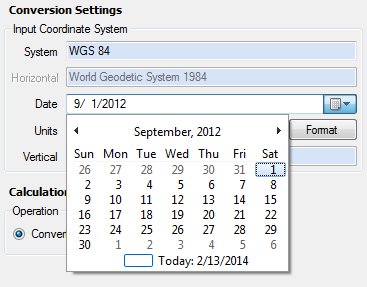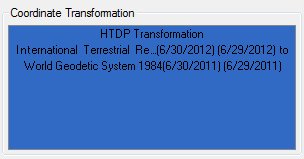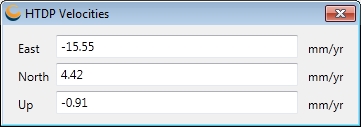Time-Dependent Transformations
Time-Dependent Transformations provide a means to predict and adjust for horizontal datum transformations related to movements of the Earth's crust over time. Horizontal Time Dependent Positioning (HTDP), the Time-Dependent Helmert transformation, and Canadian Velocity Grid are options for this type of transformation available in Geographic Calculator.
HTDP
HTDP coordinate reference systems in the Geodetic Datasource can be identified by checking the horizontal datum they are based on. If the datum has an HTDP identifier, it is an HTDP system. The HTDP code will match up that datum to one of those defined in the NOAA, NGS HTDP software package (version 3) that can be found at the NGS website.
Time Dependent Helmert Transformations
Time-Dependant Helmert Transformations transform between two known coordinate systems. Some exist in the datasource by default. They can also be defined in the datasource, see Datum Transformation Definitions for more information.
Canadian Velocity Grid
The Canadian Velocity Grid accounts for shifts in tectonic plates between epochs. For more information see Canadian Velocity Grid
Time-Specific Coordinate Frame Rotation (CFR) and Time-Specific Position Vector Rotation (PVR)
The Eight Parameter EPSG transformations can be CFR (coordinate frame roatation) or PVR (position vector rotation) methods. As time-fixed transforms these transformations are only valid a a given time. For more information see Time-Specific CFR and PVR transformations.
Selecting Time Dependent Transformations
By default, date fields will be enabled for all coordinate system definitions. This setting can be changed within the Preferences Menu. When the date field is enabled, click on it to select a date:

If the time-dependent transformations are enabled in Preferences, and the Date fields are set, any valid time-dependant datum transformations will be included in possible results for your Coordinate Transformation.

Note: For the 14-parameter transformation model, only a Target date is valid and these transformations will not be shown if a Source Date is entered and it does not match the Target Date
In the case of HTDP selection: If both the source and target coordinate systems do support HTDP, and have active specified dates, then an HTDP transformation will be created for use by the current calculation. This datum transformation will not be added to the custom datasource and is not viewable in the Datasource dialogs. It is constructed based on the current transformation. The Datum Transformation field will be updated with text describing the transformation.

If the Workspace is saved at this point, the HTDP transformation will be restored when the application is restarted.
In the Interactive Conversion Job, the HTDP Velocity values may be viewed by right-clicking on the output values in the Coordinate Point Definition field for the transformation output and selecting the 'HTDP Velocity' options.
In the Point Database Conversion Job, be sure that the "Show Time Dependent Velocities" option is enabled in Options>Preferences>Point Database. The boxes will appear in the Point Database Conversion menu when a Time Dependent Transformation is selected.
Selecting this option will bring up a window (below) displaying the East,
North and Up velocity values in millimeters per year.

"North" velocity is measured as true north for geodetic, or grid north for projected.
"Up" velocity is measured as change in elevation from the location you started along an imaginary line that is perpendicular to the ellipsoid.